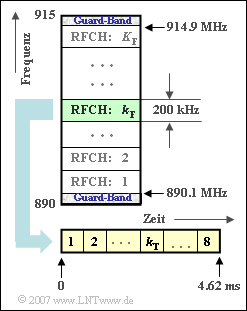Difference between revisions of "Aufgaben:Exercise 3.3Z: GSM 900 and GSM 1800"
From LNTwww
m (Text replacement - "Category:Aufgaben zu Beispiele von Nachrichtensystemen" to "Category:Examples of Communication Systems: Exercises") |
|||
| Line 1: | Line 1: | ||
| − | {{quiz-Header|Buchseite= | + | {{quiz-Header|Buchseite=Examples_of_Communication_Systems/Radio_Interface |
}} | }} | ||
| − | [[File:P_ID1225__Bei_Z_3_3.png|right|frame|$\rm GSM \ 900$ | + | [[File:P_ID1225__Bei_Z_3_3.png|right|frame|$\rm GSM \ 900$ and $\rm GSM \ 1800$]] |
| − | + | The mobile communications standard established in Europe since $1992$ $\rm GSM$ (''Global System for Mobile Communications'') uses frequency and time division multiplexing to enable multiple users to communicate in one cell. | |
| − | + | The following are important characteristics of the system shown in the diagram $\rm GSM \ 900$ in somewhat simplified form. | |
| − | * | + | *The frequency band of the uplink (the connection from the mobile to the base station) is between $890\ \rm MHz$ and $915 \ \rm MHz$. |
| − | * | + | *Taking into account the guard bands at both ends, a total bandwidth of $24.8 \ \rm MHz$ is thus available for the uplink. |
| − | * | + | *This band is used by a total of $K_{\rm F}$ subchannels (''Radio Frequency Channels''), which are adjacent to each other with respective frequency spacing $200 \ \rm kHz$ . The numbering is done with the run variable $k_{\rm F}$. |
| − | * | + | *The frequency range for the downlink (the connection from the base station to the mobile station) is located around the duplex spacing $45 \ \rm MHz$ above the uplink and is otherwise structured in the same way as the latter. |
| − | * | + | *Each of these FDMA subchannels is used simultaneously by $K_{\rm T} = 8$ subscribers in time division multiple access (''TDMA''). |
| − | + | The GSM $1800$ system is structured in a similar way, but with the following differences: | |
| − | * | + | *The frequency range of the uplink is between $1710 \ \rm MHz$ and $1785 \ \rm MHz$. |
| − | * | + | *The duplex spacing is $95 \ \rm MHz$. |
| Line 25: | Line 25: | ||
| − | + | Hints: | |
| − | * | + | *This exercise belongs to the chapter [[Examples_of_Communication_Systems/Radio_Interface|"Radio Interface"]]. |
| − | * | + | *Reference is made in particular to the page [[Examples_of_Communication_Systems/Radio_Interface#Realization_of_FDMA_and_TDMA|"Realization of FDMA and TDMA"]] |
| − | === | + | ===Questions=== |
<quiz display=simple> | <quiz display=simple> | ||
Revision as of 20:59, 30 December 2022
The mobile communications standard established in Europe since $1992$ $\rm GSM$ (Global System for Mobile Communications) uses frequency and time division multiplexing to enable multiple users to communicate in one cell.
The following are important characteristics of the system shown in the diagram $\rm GSM \ 900$ in somewhat simplified form.
- The frequency band of the uplink (the connection from the mobile to the base station) is between $890\ \rm MHz$ and $915 \ \rm MHz$.
- Taking into account the guard bands at both ends, a total bandwidth of $24.8 \ \rm MHz$ is thus available for the uplink.
- This band is used by a total of $K_{\rm F}$ subchannels (Radio Frequency Channels), which are adjacent to each other with respective frequency spacing $200 \ \rm kHz$ . The numbering is done with the run variable $k_{\rm F}$.
- The frequency range for the downlink (the connection from the base station to the mobile station) is located around the duplex spacing $45 \ \rm MHz$ above the uplink and is otherwise structured in the same way as the latter.
- Each of these FDMA subchannels is used simultaneously by $K_{\rm T} = 8$ subscribers in time division multiple access (TDMA).
The GSM $1800$ system is structured in a similar way, but with the following differences:
- The frequency range of the uplink is between $1710 \ \rm MHz$ and $1785 \ \rm MHz$.
- The duplex spacing is $95 \ \rm MHz$.
Hints:
- This exercise belongs to the chapter "Radio Interface".
- Reference is made in particular to the page "Realization of FDMA and TDMA"
Questions
Musterlösung
(1) Aus der Gesamtbandbreite von $25 \ {\rm MHz}\ (800 \text{...} 915 \ \rm MHz)$, den beiden Schutzbereichen von je $100 \ \rm kHz$ an den Rändern und dem Kanalabstand $200 \ \rm kHz$ ergibt sich für das $\rm GSM \ 900$:
- $$K_{\rm F} = \frac{ 914.9 \,{\rm MHz}- 890.1 \,{\rm MHz}}{0.2 \,{\rm MHz}} \hspace{0.15cm} \underline {= 124}\hspace{0.05cm}.$$
(2) Beim $\rm GSM \ 1800$ steht nun in jeder Richtung eine Bandbreite von $75 \ \rm MHz$ zur Verfügung.
- Unter Berücksichtigung der beiden Schutzbänder und des gleichen Kanalabstandes $200 \ \rm kHz$ erhält man hier:
- $$K_{\rm F} = \frac{ 75 \,{\rm MHz}- 0.2 \,{\rm MHz}}{0.2 \,{\rm MHz}} \hspace{0.15cm} \underline {= 374}\hspace{0.05cm}.$$
(3) Beim $\rm GSM \ 1800$ beginnt der Uplink bei $1710 \ \rm MHz$ und der Downlink bei
- $$1710 \,{\rm MHz}\,\,({\rm Uplink})+ 95 \,{\rm MHz}\,\,({\rm Duplexabstand}) ={1805 \,{\rm MHz}} \hspace{0.05cm}.$$
- Der erste Downlink–Kanal $(k_{\rm F} = 1)$ liegt um die Mittenfrequenz $f_{\rm M} = 1805.2 \ \rm MHz$ höher,
- der Kanal mit der Nummer $k_{\rm F} = 200$ um den Frequenzabstand $199 \cdot 0.2 \ \rm MHz$:
- $$f_{\rm M} (k_{\rm F} = 200) \hspace{0.15cm} \underline { = {1845 \,{\rm MHz}}} \hspace{0.05cm}.$$
(4) Mit dem Ergebnis der Teilaufgabe (2) und $K_{\rm T} = 8$ erhält man:
- $$K ({\rm GSM \hspace{0.15cm}1800}) = 374 \cdot 8 \hspace{0.15cm} \underline { = 2992}\hspace{0.05cm}.$$
